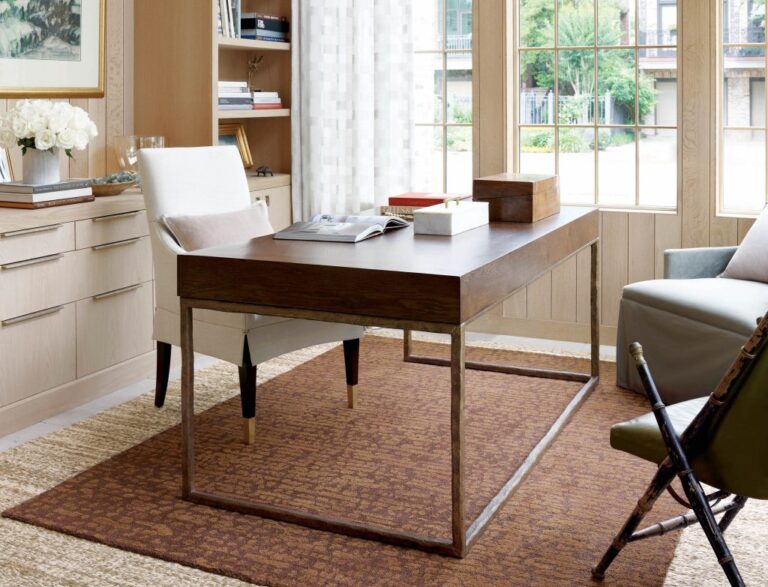If the rug you love is too small, the perfect solution is to place a smaller rug on top of a larger neutral rug. This layer acts like a border that extends the rug, says rug expert Jess Evans. (Courtesy of Annie Selke)
My friend Susan and I disagreed on pretty much everything except home design… until now. Sure, I know that an 8' x 10' area rug would have been a perfect fit for our 10' x 13' living room, but I already had a 5' x 8' rug. I loved the pattern and the colors—navy and burnt orange—so I made the rug the focal point of my decor.
She stands by her stance: “If I insist on keeping the small rug (yes), I should buy a larger solid color rug to layer underneath it and place that under the furniture to unify the room,” she said.
So when the rugs arrived, I rolled out the big navy rug, put the smaller rug on top of it, put the furniture back, and sent Susan the pictures. “Are you happy with this?” I asked.
“Yes, but I think a dark orange would have been better.”
I was lucky she lived six states away or I would have strangled her.
So I texted the same photo to my designer friend Christopher, who I often consult with. Unlike Susan, he's not involved in this fight. His response was, “That blue rug makes everything in the room look cheap. How about a deep orange rug?” He doesn't understand how serious a topic this is.
Okay, so I ordered a solid dark orange wool rug online. I rolled up the blue rug and dragged it out of the living room like a dead sea mammal. I unrolled the orange rug and thought to myself, I'm gonna love this.
I step back and squint. The orange is pretty bright. And the smaller rug remains wrinkled no matter how hard I try to stretch it. I text the photo to Susan and Christopher.
“It's too light,” said Susan. “It should be darker.”
“I'm never doing this again,” I replied. “You can either have an orange rug or you can have no orange rug.”
“I cannot choose between two bad options without feeling guilty,” she writes.
Christopher has a more witty suggestion: “Try putting an orange rug in your bedroom. It's better to have no rug at all than to have a smaller rug underneath that gets in the way.”
To settle things, I called Jess Evans, vice president of design at Massachusetts-based rug manufacturer Annie Selke, and asked if I could interview her for a column on rug sizes. Little did she know what she was getting into. I sent her a photo of her living room.
“If you put a small rug in a room with no other furniture around it, it can really make it obvious that the rug is too small for the space,” she says. “While I always recommend buying the right size rug from the start, I also love the layered look, and so do many top designers.” (Don't tell Susan.)
“But wouldn't putting a smaller rug on top of a larger one just emphasize the fact that the rug on top is too small?”
“Not at all,” she said. “Stacking rugs is the perfect solution when your favorite rug is too small. The stacking acts like a border that extends the rug, making the combination just as good as a single rug.”
After my first two attempts at layering were unsuccessful, I asked Evans for advice on how to get the base right and other solutions to rug size issues. Here's her advice:
Eliminate waste: To keep stacked rugs from twisting, look for a thin base layer with a pile height of 1/4 inch or less, she says. It should also have a flat texture. Thinner, more durable rugs can be made from jute, sisal, wool or polypropylene.
Avoid patterns: Choose a base layer with little to no pattern in a neutral color that matches your flooring. The base will act as a frame and not compete with your main rug.
Add the legs: Ideally, the rug should be large enough to accommodate at least the front legs of the room's main furniture. If you are only installing the front legs, you will need to extend the underside of the rug by a few inches. If you can't install all the legs, it is better to have no legs at all than some legs attached and some removed.
However, make sure not to make it too big. Leave at least 8 inches of space between the rug and the wall; 18 inches is ideal, and anything less than 6 inches is too narrow. “If the rug is too large, it will look like wall-to-wall carpeting, which defeats the purpose of an area rug,” says Evans.
Make room for your chair: Rugs under dining tables should extend over the table by at least 24 inches so diners can move their chairs in and out without getting caught. If you can't do that, don't have a rug.
Getting naked: “Don't overload your home with rugs,” says Richard Mann, owner of Robert Mann Rugs in Denver. “If you have beautiful wood or stone floors, it's nice to show them off.”
Per Evans' suggestion, I ordered another rug, a plain 1/4 inch tan jute rug, and if that doesn't work out, I'll stick with just the rug and make a new friend.
Join lifestyle columnist Marni Jameson for a free virtual event, “Rightsize Your Life and Live Well Now,” on May 23. Register at https://extras.mercurynews.com/events/ and contact her at marni@marnijameson.com.


